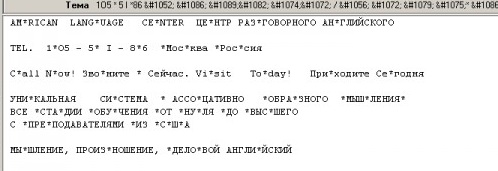Letters that annoy us
The industry of legal mailings, which is gradually gaining momentum in the Russian networks, has existed in the west for more than ten years. During this time, the industry leading companies have done a great job, collecting and summarizing the methods of creating a successful advertising campaign. Alas, in RuNet, the rules for creating a competent and effective e-mail did not have time to settle down.
Composers of letters are lazy to put themselves in the reader's place and continue to attack the same rake, making silly mistakes annoying the reader. And advertising campaigns not only do not pay back the money spent on them, but also spoil the impression of the audience.

')
In this article we will focus on the most obvious and, oddly enough, often admitted by the drafters.
Based on the article by Carissa Newton, marketing director of Delivra's legal mailing company, especially for UniSender Harablog .
Sites that provide access to a wide range of information often do not take into account the fact that most subscribers are interested in only a small part of their content. As a result, "generalists" send out a mass of useless correspondence, choosing from which the right is more difficult than simply unsubscribing from the newsletter.
You just need to make a list of topics and offer them to the reader. Even if this requires time and effort, later it will pay off with a much smaller number of formal replies.
When it comes to communicating with a subscriber, many advertisers believe that the more the better. Not at all: legal distribution companies were surprised to find that the peak of formal replies falls on the increase in the frequency of sending correspondence.
The best solution would be to let the user decide for himself how often he wants to receive a regular mailing or even indicate on what days he wants to see it in his mail - as he does, for example, Ozon.ru :

Many corporate mail system administrators turn off the display of pictures to save server space and prevent spam. The same for the convenience of working with text is sometimes done by ordinary users. Legal mailing companies lose a serious part of the audience only due to the fact that subscribers cannot read letters in pictures. The images will be replaced with a red cross, well-known to the user, associated with an error or spam, to which the letter will probably be counted immediately.

The likelihood that the user will not see the pictures does not mean that they should be abandoned altogether. Create letters for which pictures are not the basis, but a nice addition. So that everyone can appreciate the letter, regardless of the settings and features of the mail provider.
E-mails are good because they combine brevity and information content, becoming the optimal container for an advertising message that you cannot fit into an SMS or banner. One glance should be enough to interest the user, and one minute to let him fully familiarize himself with the letter. Text in the size of four pages of Word will scare away even the interested reader: this volume should be read with preliminary preparation. Although there are pleasant exceptions . It should be offered to the subscriber when he already began to consider your message not just advertising, but curious or even important information.
If there is a need to convey more information, the use of hyperlinks will be a good move. Interested users will be able to familiarize themselves with the details, and you will appreciate the effectiveness of the letters by the number of people following the link. But you shouldn't get carried away either: it is considered that more than three or five hyperlinks can make the letter too “colorful”.
A neat person will hardly leave home without looking in the mirror. But, alas, even some decent companies allow themselves to send letters without first checking them.
If we are talking about information, then excessive control is never superfluous. Before sending a message, make sure that messages are displayed without errors by different email clients and mobile devices. It is necessary to have test mailboxes at different mail clients, at least for the largest or most popular among your readers. A banal spell checker included in the interface of most email clients is often not enough: do not be lazy to re-read the letter yourself. Check if the links work and if there are any typos in the text.
The fact that your client left his email address does not mean that he wants to receive your newsletter. And far from each of them the sales letter from you will be a pleasant surprise. Most rightly send it to spam.
Than trying to write to an audience that doesn’t express your desire to read, it’s better to make the subscription mechanism visible and accessible (article “ Seven ways to increase the number of your subscribers .” Offer it to users who read news and follow new promotions on the site. Post a link to the subscription form on the pages on social networks and twitter.
Social networks are the best place to continue the dialogue with your subscribers. After all, any logical continuation of the publication of the news is its discussion. Interested users repost the news they like, and the effectiveness of the advertising campaign grows exponentially. Emails without links to Twitter, Vkontakte, Facebook lose this exceptional opportunity.
Composers of letters are lazy to put themselves in the reader's place and continue to attack the same rake, making silly mistakes annoying the reader. And advertising campaigns not only do not pay back the money spent on them, but also spoil the impression of the audience.

')
In this article we will focus on the most obvious and, oddly enough, often admitted by the drafters.
Based on the article by Carissa Newton, marketing director of Delivra's legal mailing company, especially for UniSender Harablog .
1. One - for all
Sites that provide access to a wide range of information often do not take into account the fact that most subscribers are interested in only a small part of their content. As a result, "generalists" send out a mass of useless correspondence, choosing from which the right is more difficult than simply unsubscribing from the newsletter.
You just need to make a list of topics and offer them to the reader. Even if this requires time and effort, later it will pay off with a much smaller number of formal replies.
2. Intrusive Advertising
When it comes to communicating with a subscriber, many advertisers believe that the more the better. Not at all: legal distribution companies were surprised to find that the peak of formal replies falls on the increase in the frequency of sending correspondence.
The best solution would be to let the user decide for himself how often he wants to receive a regular mailing or even indicate on what days he wants to see it in his mail - as he does, for example, Ozon.ru :

3. JPEG distribution
Many corporate mail system administrators turn off the display of pictures to save server space and prevent spam. The same for the convenience of working with text is sometimes done by ordinary users. Legal mailing companies lose a serious part of the audience only due to the fact that subscribers cannot read letters in pictures. The images will be replaced with a red cross, well-known to the user, associated with an error or spam, to which the letter will probably be counted immediately.

The likelihood that the user will not see the pictures does not mean that they should be abandoned altogether. Create letters for which pictures are not the basis, but a nice addition. So that everyone can appreciate the letter, regardless of the settings and features of the mail provider.
4. Too long letters
E-mails are good because they combine brevity and information content, becoming the optimal container for an advertising message that you cannot fit into an SMS or banner. One glance should be enough to interest the user, and one minute to let him fully familiarize himself with the letter. Text in the size of four pages of Word will scare away even the interested reader: this volume should be read with preliminary preparation. Although there are pleasant exceptions . It should be offered to the subscriber when he already began to consider your message not just advertising, but curious or even important information.
Read the letter, the beginning and end of the text which fit on one screen.
If there is a need to convey more information, the use of hyperlinks will be a good move. Interested users will be able to familiarize themselves with the details, and you will appreciate the effectiveness of the letters by the number of people following the link. But you shouldn't get carried away either: it is considered that more than three or five hyperlinks can make the letter too “colorful”.
5. Sloppy letters
A neat person will hardly leave home without looking in the mirror. But, alas, even some decent companies allow themselves to send letters without first checking them.
If we are talking about information, then excessive control is never superfluous. Before sending a message, make sure that messages are displayed without errors by different email clients and mobile devices. It is necessary to have test mailboxes at different mail clients, at least for the largest or most popular among your readers. A banal spell checker included in the interface of most email clients is often not enough: do not be lazy to re-read the letter yourself. Check if the links work and if there are any typos in the text.
And remember: even a well-written, informative and interesting text with only one stupid blooper will be remembered by this very blooper.
6. Unsolicited Letters
The fact that your client left his email address does not mean that he wants to receive your newsletter. And far from each of them the sales letter from you will be a pleasant surprise. Most rightly send it to spam.
Than trying to write to an audience that doesn’t express your desire to read, it’s better to make the subscription mechanism visible and accessible (article “ Seven ways to increase the number of your subscribers .” Offer it to users who read news and follow new promotions on the site. Post a link to the subscription form on the pages on social networks and twitter.
Do not worry about reducing the address list: cleared of disinterested customers, he lost in quantity, but acquired as.
7. Lack of links to social networks
Social networks are the best place to continue the dialogue with your subscribers. After all, any logical continuation of the publication of the news is its discussion. Interested users repost the news they like, and the effectiveness of the advertising campaign grows exponentially. Emails without links to Twitter, Vkontakte, Facebook lose this exceptional opportunity.
Source: https://habr.com/ru/post/129320/
All Articles